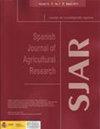营养卫生管理对蜜蜂种群动态和病原菌负荷的影响
IF 0.8
4区 农林科学
Q3 AGRICULTURE, MULTIDISCIPLINARY
引用次数: 0
摘要
研究目的:本研究的目的是评估冬季、次年春季和夏季螨类控制策略与营养管理相结合对蜜蜂群体动态和生存的影响。研究区域:阿根廷中部的圣达菲省。材料和方法:我们设置了两个养蜂场,每个养蜂场有40个菌落,其中一个养蜂场用高果糖玉米糖浆(HFCS)喂养,另一个养蜂厂用蔗糖糖浆(SS)喂养。在每个养蜂场内,我们对一半的蜂群进行了抗瓦螨处理,其中一半的蜂群还接受了花粉饼。另一半的菌落仍然没有得到治疗,也没有得到花粉饼。在一年中(从2016年夏天到2017年秋天),对所有菌落进行了七次Varroa侵扰水平、角鼻蛛丰度和菌落强度的采样。我们计算了每个采样时间的秋螨入侵和群落损失。主要结果:在研究过程中,喂食HFCS的蜂群有更多的孵化细胞,而喂食SS和处理过的蜂群比未处理的蜂群有更少的成年蜜蜂和瓦螨侵扰。没有观察到蛋白质补充对任何反应变量的显著影响,所有组的SS菌落的螨虫脱落计数均显著高于HFCS菌落。研究重点:考虑到减少应用频率是可取的,我们的研究结果表明,营养管理可以提高化学处理的有效性,因为蜜蜂可能从改善营养中受益。然而,需要更好地了解田间条件下菌落的营养需求。本文章由计算机程序翻译,如有差异,请以英文原文为准。
Impact of nutritional and sanitary management on Apis mellifera colony dynamics and pathogen loads
Aim of study: The aim of this study was to assess the impact of the mite control strategies combined with nutritional management on honey bee colony dynamics and survival during winter, the following spring, and summer.
Area of study: Santa Fe province in central Argentina.
Material and methods: We set two apiaries with 40 colonies each and fed one apiary with high fructose corn syrup (HFCS) and the other with sucrose syrup (SS). Within each apiary, we treated half the colonies against Varroa mites and half of these treated colonies also received a pollen patty. The other half of the colonies remained untreated and did not received pollen patties. All colonies were sampled for Varroa infestation level, Nosema ceranae abundance and colony strength seven times during a year (from summer 2016 to autumn 2017). We computed autumn mite invasion and colony losses at each sampling time.
Main results: Colonies fed with HFCS had more brood cells during the study that those fed with SS and treated colonies had fewer adult bees and Varroa infestation than untreated colonies. No significant effect of the protein supplementation was observed on any of the response variables. , SS colonies from all groups had significantly more mites drop counts than HFCS colonies.
Research highlights: Considering that a reduced frequency of application is desirable, our results suggested that nutrition management could enhance chemical treatment effectiveness since honey bees might profit from improved nutrition. However, a better understanding of the nutritional requirements of the colonies under field conditions is needed.
求助全文
通过发布文献求助,成功后即可免费获取论文全文。
去求助
来源期刊

Spanish Journal of Agricultural Research
农林科学-农业综合
CiteScore
2.00
自引率
0.00%
发文量
60
审稿时长
6 months
期刊介绍:
The Spanish Journal of Agricultural Research (SJAR) is a quarterly international journal that accepts research articles, reviews and short communications of content related to agriculture. Research articles and short communications must report original work not previously published in any language and not under consideration for publication elsewhere.
The main aim of SJAR is to publish papers that report research findings on the following topics: agricultural economics; agricultural engineering; agricultural environment and ecology; animal breeding, genetics and reproduction; animal health and welfare; animal production; plant breeding, genetics and genetic resources; plant physiology; plant production (field and horticultural crops); plant protection; soil science; and water management.
 求助内容:
求助内容: 应助结果提醒方式:
应助结果提醒方式:


